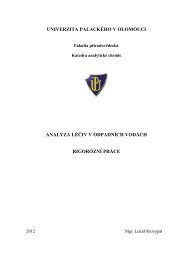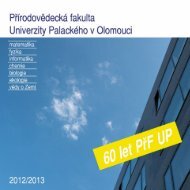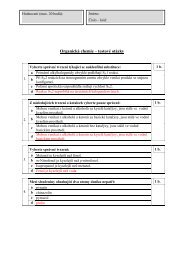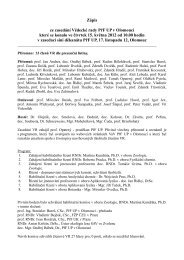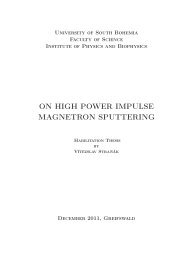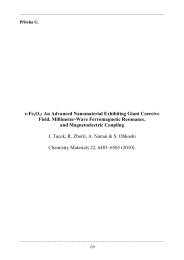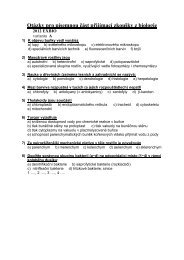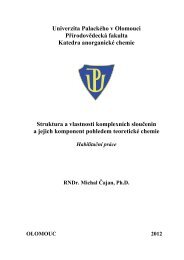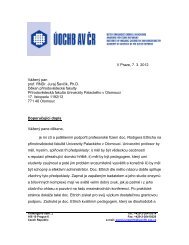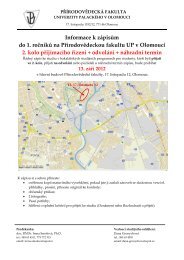A comparative structural analysis of direct and indirect shoot ...
A comparative structural analysis of direct and indirect shoot ...
A comparative structural analysis of direct and indirect shoot ...
You also want an ePaper? Increase the reach of your titles
YUMPU automatically turns print PDFs into web optimized ePapers that Google loves.
Stress MAP kinase SIMK in plant tip growth<br />
Fig. 7. Video-enhanced microscopy <strong>of</strong> growing root hairs treated with UO 126. (A) An untreated growing alfalfa root hair with a vesicle-rich apical<br />
dome. (B±F) Alfalfa root hair treated with 10 mM UO 126. Note that UO 126 markedly changes the cytoarchitecture <strong>and</strong> shape <strong>of</strong> the root hair apex<br />
causing inhibition <strong>of</strong> root hair tip growth. (G±I) Tobacco growing root hair treated with 10 mM UO 126. This concentration <strong>of</strong> UO 126 caused growth<br />
arrest within 5 min <strong>and</strong> similar changes in the cytoarchitecture <strong>and</strong> shape <strong>of</strong> the root hair apex to those in alfalfa (A±F). (J±L) Tobacco SIMK-GOF<br />
root hair treated with 10 mM UO 126 (J <strong>and</strong> K) or 100 mM UO 126 (L) for the indicated time points. Note that 10 mM UO126 did not cause growth<br />
arrest <strong>and</strong> changes in root hair cytoarchitecture <strong>and</strong> shape within 60 min, while 100 mM UO 126 inhibits root hair growth within 60 min, causing<br />
minor changes in the cytoarchitecture. Bar = 7 mm for (A±F) <strong>and</strong> 5 mm for (G±L).<br />
culminating in the onset <strong>of</strong> root hair tip growth (Braun<br />
et al., 1999; Miller et al., 1999; BalusÏka et al., 2000a).<br />
SIMK localization <strong>and</strong> activity are associated with<br />
actin organization<br />
Dense F-actin meshworks at root hair tips <strong>of</strong> different plant<br />
species were observed in root hairs by immunolabeling<br />
with actin antibodies or in vivo using green ¯uorescent<br />
protein (GFP) fused to the F-actin-binding domain <strong>of</strong> talin<br />
(Braun et al., 1999; BalusÏka et al., 2000a; BalusÏka <strong>and</strong><br />
Volkmann, 2002). An intact actin cytoskeleton is necessary<br />
for root hair tip growth because root hairs treated with<br />
the F-actin disruptors LB or cytochalasin D are inhibited in<br />
their growth <strong>and</strong> show morphological abnormalities<br />
(Miller et al., 1999; BalusÏka et al., 2000a; Ovecka et al.,<br />
2000). F-actin recruitment towards root hair bulges <strong>and</strong><br />
growing tips roughly coincides with local accumulations<br />
<strong>of</strong> actin-depolymerizing factor (ADF) (Jiang et al., 1997),<br />
pro®lin (Braun et al., 1999; BalusÏka et al., 2000a) <strong>and</strong> Rop<br />
GTPases (Molendijk et al., 2001). SIMK was found to<br />
localize within tips <strong>of</strong> growing root hairs. Tip-focused<br />
localization <strong>of</strong> SIMK disappeared after treatment with LB<br />
<strong>and</strong> resulted in nuclear accumulation <strong>of</strong> SIMK. The<br />
association <strong>of</strong> SIMK with ®lamentous actin could be<br />
enhanced by jasplakinolide, an inducer <strong>of</strong> actin polymerization.<br />
These ®ndings indicate that an intact actin<br />
cytoskeleton is necessary for the proper localization <strong>of</strong><br />
SIMK within root hair tips. Interestingly, both actin drugs<br />
activate SIMK in suspension-cultured root cells, suggesting<br />
that the state <strong>and</strong> dynamics <strong>of</strong> the actin cytoskeleton<br />
<strong>direct</strong>ly in¯uence SIMK activity. Actin reorganization is<br />
likely to be mediated by actin-binding proteins (e.g.<br />
pro®lin, ADF, villin, ARP, ®mbrin <strong>and</strong> calponin), <strong>and</strong><br />
SIMK might phosphorylate <strong>and</strong> regulate one <strong>of</strong> these<br />
actin-binding proteins. Both ADF <strong>and</strong> pro®lin are actinbinding<br />
proteins responsible for the dynamics <strong>of</strong> F-actin<br />
meshworks (for a review on plant cells see Staiger, 2000).<br />
Presently, it is not clear which actin cytoskeletal proteins<br />
are targeted by SIMK in vivo. In animal cells, p38<br />
regulates the dynamic organization <strong>of</strong> the actin cytoskeleton<br />
via phosphorylation <strong>of</strong> the small heat shock protein<br />
HSP27 (SchaÈfer et al., 1998). HSP27 acts as an F-actincapping<br />
protein inhibiting polymerization <strong>of</strong> G-actin in its<br />
phosphorylated state (Benndorf et al., 1994). Interestingly,<br />
3303




